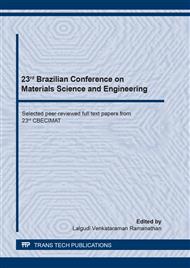p.390
p.395
p.401
p.407
p.412
p.418
p.424
p.430
p.436
Calibration of the AC Potential Dropping System (ACPD) for Determination of Crack Growth in API 5L X65 Steel under Cathodic Protection Effect
Abstract:
In this work the calibration of an Alternative Current Potential Drop (ACPD) system was performed to monitore laboratory mechanical tests on marine environment under cathodic protection. The calibration was done on CT type specimens of API 5L X65 steel dimensioned according to ASTM E1820 standard., The crack propagation during a tensile test with displacement control in an ACPD equipment was monitored through the performs points collection by two channels: one that monitors the crack growth and another that monitors a region free of crack. Using a profile projector and graphical data processing and analysis software, the area of the fracture surface of the specimen was meansured, which allowed to correlate a crack size with a corresponding value of potential drop and the calibration curve. In order to verify verify the efficacy and precision of the technique, step loading tests were performed on API 5L X65 steel test specimens, submerged in synthetic sea water under the overprotection potential of-1300mVAg/AgCl. The results of the calibration showed few dispersed errors, and the main factors of this dispersion may be related to the geometry of the specimen and with variations in current flow density, which is influenced by corners and edges and by the presence of pick-up inductive. The calibration and its effectiveness can be verified through the results of the tests in marine environment, presenting crack lengths close to the actual values, confirming the effectiveness of the ACPD technique.
Info:
Periodical:
Pages:
412-417
Citation:
Online since:
October 2020
Price:
Сopyright:
© 2020 Trans Tech Publications Ltd. All Rights Reserved
Share:
Citation:


